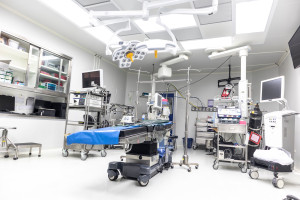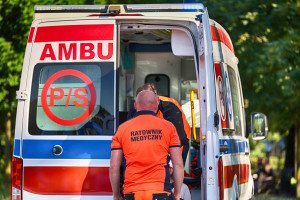Fast track for e-innovation. AOTMiT responds to the needs of a dynamic market

- AOTMiT has developed the first project of the so-called fast track for e-innovation, the aim of which is to more effectively implement digital medical devices into the healthcare system
- The project has been sent to market experts and will then be consulted with the Ministry of Health - informed Prof. Anna Kowalczuk, deputy president of AOTMiT during the European Economic Congress in Katowice
- Experts emphasize that in order to implement innovations in health, key questions about their purpose, method of financing, effectiveness for the system and safety of use must be answered.
Modern solutions for the healthcare sector appear every day. Their creators assure us that their solution is the remedy for the system's biggest problems: long queues, administrative burdens on medical personnel, inefficiency in resource use, and long diagnosis times. However, entities using these tools can often be counted on the fingers of one hand. What are the reasons for this state of affairs? It depends on who you ask.
IT service providers talk about the low awareness of hospital managers and insufficient funding from the state. Directors hit the ball, criticizing the greed of suppliers. Doctors, busy serving patients, are drowning in information obligations and treat ideas for further "improvements" with skepticism. Innovators criticize procedural labyrinths and the lack of interest from the state, which is why projects that could change reality end up in the drawer. Decision-makers, on the other hand, declare their willingness to introduce modern solutions, but at the same time they do not keep up with the implementation of ideas developed by EU officials.
In these conditions, some people are happy about EU programs that help finance innovations, but others point to them as the main source of market stagnation, making it difficult to focus on developing their own ways of implementing modern tools into the system.
However, there is light at the end of the tunnel. The Agency for Health Technology Assessment and Tariff System has developed the first draft of a procedure aimed at facilitating the assessment and implementation of digital medical devices in the healthcare system . The assumptions have been forwarded to one of the industry organizations for consultation. Then they will go to experts from the Ministry of Health.
What will the procedure look like? Is it possible to introduce innovations quickly while maintaining high standards of assessing their effectiveness, cost-effectiveness and safety? This was discussed by participants of the "Innovations in Health" panel, held as part of the 17th European Economic Congress in Katowice.
- Anna Kowalczuk, Deputy President of the Agency for Health Technology Assessment and Tariff System

As officials, we cannot keep up with wrapping the changing reality in legal and procedural frameworks. We also want to implement e-innovations, but this is a big challenge when they do not have full clinical trial results. However, we see grassroots initiatives, where new technologies enter clinical practice before they are formally reviewed by central institutions.
As the Agency for Health Technology Assessment and Tariff System, we are attempting to address this challenge by developing a fast track for e-innovations. Our goal is to create a procedure that will allow for the assessment of such solutions, despite the lack of standard clinical data. The fast track project assumes simplifying the process while maintaining the basic principles of health technology assessment. We will send a draft of the procedure to the first organization and scientific experts, and then to the Ministry of Health.
An important assumption is the change in the role of pilots. Until now, pilots have been treated as a basis for reimbursement decisions, and they should be used to assess the potential usefulness of the technology. Another element of the fast track will be the introduction of a risk-sharing model inspired by solutions used in drug reimbursement. Manufacturers would provide the solution on specific terms, and only after verification of its operation in real system conditions would a decision be made on its potential reimbursement.
We want to automate the process of introducing e-innovations with defined deadlines and a simple, repeatable evaluation path. Although HTA remains essential, the interpretation of requirements for digital innovations should be more flexible. At the same time, it is necessary to develop dedicated evaluation guidelines for these solutions, because at the European level there are no ready-made templates for simple adaptation.
The fast track project is also to include conditional reimbursement models, where after a year or two from implementation, the real results of using the solution in the system will be analyzed. If the clinical data is insufficient or ambiguous, there will be no possibility of further financing of the given innovation.
- Jakub Adamski, director of the cooperation department at the Office of the Patient Rights Ombudsman

Financing innovation from EU funds has certain drawbacks. Looking at the National Reconstruction Plan, for example, it imposes not only rigid deadlines, but also restrictions on the projects that can be implemented thanks to it. In such conditions, it is difficult to choose solutions that will respond to the real problems of the healthcare system. At the same time, programs such as KPO or FEnIKS have significant value because they help direct innovation towards the implementation of public goals.
The problem we see today is that we are too short-sighted - we spend money too late, without planning anything long-term. We need a system that will consciously determine in which areas we want to develop innovations and what health goals we want to achieve.
We cannot forget about the clash of two priorities: public health effects and innovation itself. For startups and technology companies, the priority is the development of innovative solutions, while for public institutions it should be primarily the health of citizens. It is therefore necessary to find a balance between supporting innovation and ensuring safety and effectiveness for patients.
We need to create a mechanism for financing and testing innovations and their subsequent implementation into the system. Otherwise, we risk repeating the mistakes in which innovations tested in pilots end up in clinical practice without proper evaluation.
It is also necessary to face the problem of risk in financing innovation. Some projects will not succeed - this is natural. The system should be prepared for this, and decisions on continuing or discontinuing financing should be made based on reliable data, not political or social pressure.
- Władysław Mizia, director and leader of healthcare consulting at Deloitte

Implementing innovations in the healthcare system requires not only financing, but above all, appropriate organization of processes. EU projects are of great value because they impose certain directions of action - for example in the digitization and computerization of hospitals. Thanks to this, it is possible to standardize processes at the national level, which would otherwise develop in an uncoordinated way.
One of the problems we are highlighting is the insufficient time to prepare implementations. For years, hospitals have been holding back investments in computerization, waiting for funds from the KPO. When the funds finally appeared, it turned out that the deadlines for their use were extremely short.
We organised information webinars and there was a huge interest – hundreds of hospitals needed urgent instructions on how to complete their projects in the required time.
The disadvantage of the current approach is that it forces quick purchasing decisions and limits the ability to adapt solutions to the real needs of individuals. Hospitals are often forced to purchase ready-made solutions, without adequate time for analysis or adapting the system to individual requirements.
The solution we propose is to create permanent mechanisms to support the development of digitalization, and not just cyclical financing actions dependent on the availability of EU funds. Innovations in healthcare should be a continuous, well-planned process, and not an action under the pressure of short-term deadlines.
It is equally important to create a clear path for introducing innovations - from the idea stage, through pilots, to full implementation. Anyone who wants to introduce new solutions to the market should know the rules of the game: what criteria must be met, how to conduct a pilot, what are the possibilities of financial support and what the further path to implementation looks like.
The lack of structured paths means that some innovations are lost at early stages or enter the system without proper preparation.
- Łukasz Sosnowski, operational partner of the Physician Innovators Network of the Supreme Medical Chamber

There is no shortage of sources of innovation in Polish healthcare. In addition to large pharmaceutical companies and manufacturers of medical devices, grassroots initiatives play a key role - ideas from doctors, nurses or patients' families, arising from real needs. We have huge potential, but we still lack a well-thought-out system that would allow not only the creation of new solutions, but above all, their effective implementation.
Today, we operate on a point-by-point basis. There are good programs, such as those in the Medical Research Agency, but these are still pieces of a larger puzzle. The biggest challenge is the lack of a clear path from idea to implementation. Innovations are created, sometimes even undergoing pilots, but then decisions are often lacking: what next? The system currently does not have mechanisms in place that would enable a smooth transition from pilot to widespread implementation.
Another key problem is the financing model. Even the best solutions can get stuck when there is no one to pay for them. The public payer will not finance something that has not passed administrative procedures, private insurers look out for their own interests, and patients expect everything "for free". Without systemic solutions for financing innovations - many great ideas simply fall by the wayside.
We also need to separate two things: financing health and innovation. The health system should provide security and stability, but innovation requires greater flexibility and tolerance for risk. Examples from France and Germany show that new solutions can be introduced conditionally - giving them a chance for half a year or a year, and then, based on real data, make decisions about further financing.
It is also important to evaluate innovations not only in terms of clinical effectiveness, but also systemic effects. It is not only whether a new solution works that counts, but also whether it actually improves the efficiency of the system, whether it is cost-effective. We need to build mechanisms that will allow for quick and reliable evaluation of the real results of implementations.
- Ireneusz Staroń, Deputy President for Research Financing at the Medical Research Agency

The Medical Research Agency has recognized the need to support non-commercial clinical trials since its inception, but it quickly became clear that this was not enough given the market needs. Activities were expanded to include projects for enterprises and the development of drug technologies and medical devices. The problem was the scattered research infrastructure - the response was the creation of Clinical Research Support Centers and Regional Digital Medicine Centers to better integrate and use medical data.
ABM strives to build coherent funding programmes not only from EU funds, but also from national funds, in order to maintain the stability of investments in health innovations regardless of the availability of European funds.
The challenge is the lack of a single operational strategy for the development of health innovations. Although formally there is a plan for the development of the biomedical sector, it needs to be updated and the private sector needs to be more involved in its creation. In response to this gap, ABM has also begun work on a strategy for the development of the clinical research sector in Poland, in order to more closely link the development of innovations with the real needs of the healthcare system.
The Warsaw Health Innovation Hub platform was also created, where projects are consulted with the public sector already at the planning stage, which is intended to shorten the path from idea to actual implementation.
For innovations to truly change the system, mechanisms are needed to test and adapt clinical trial results to reimbursement decisions. Positive examples, such as projects on the treatment of hepatitis C or acute lymphoblastic leukemia, have shown that well-designed studies can lead to lasting changes in drug programs and improve patients' access to modern therapies.
- Wioletta Śląska-Zyśk, general director of the Warmia-Masuria Center for Lung Diseases in Olsztyn

First of all, we encounter serious financial constraints. Although the National Reconstruction Plan has provided certain opportunities, in practice there are still far too few funds for research, development and implementation of modern solutions. Financial competitions are limited, purchase conditions are rigid, and the time to use the funds is extremely short.
Another problem is the lack of funds for so-called soft activities - such as remote monitoring of patients or implementation of digital solutions supporting rehabilitation. Transnational projects in which we are involved as a relatively small hospital show that with appropriate support, facilities can be prepared to work in crisis conditions, remote services can be implemented and the quality of care can be improved. However, at the national level, such financing options are still lacking.
We are looking for bottom-up solutions - we cooperate with universities, test the automation of administrative and clinical processes. For example, by implementing RPA technology, we relieve staff from repetitive tasks, so doctors and nurses can devote more time to patients. We can already see the effects: better time management, improved quality of services and increased patient satisfaction.
- Grzegorz Zając, R&D Hub Poland leader at GSK

From a global perspective, we observe that countries investing in preventive, personalized and predictive medicine achieve the best results. Innovation is not only about inventing individual technologies, but also about the systemic introduction of new models of healthcare. In Poland, despite increasing expenditure on research and development, the process of implementing innovation is still too slow.
Global indicators clearly show our place - in the World Healthcare Innovation Index, Poland ranks last, 32nd among developed countries. The biggest gaps concern quality, access to care and the pace of transferring innovations to clinical practice. Systemically, we are well prepared to finance innovations, but their effective implementation remains a problem.
We need to move faster from idea, through pilot, to broad implementation of new solutions. The key is to speed up evaluation paths, shorten the time needed for reimbursement decisions, and provide support for projects that prove their effectiveness on a small scale.
It is also necessary to increase the system's resistance to potential failures. Innovation always involves risk, and a lack of tolerance for errors inhibits development. We must accept that some projects will not end in success and learn to draw conclusions quickly, instead of completely blocking further attempts.
Finally, it is crucial to strengthen the competences of people involved in the development of innovations - especially in the field of knowledge about scaling projects, finding investors and effective commercialization of solutions. Without this, even the best ideas will not reach patients.
Copyrighted material - reprint rules are specified in the regulations .
rynekzdrowia










